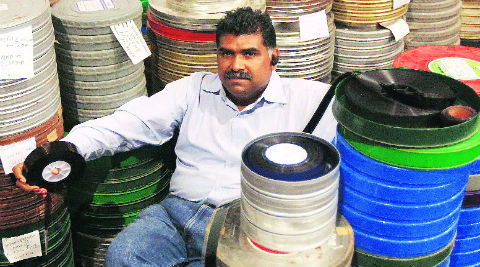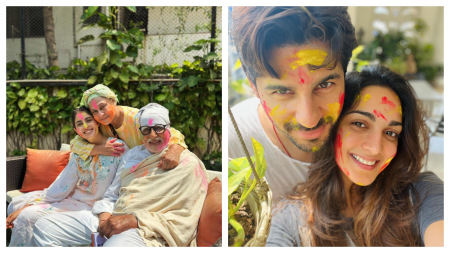- India
- International
The Man With the sharpest cut
The digital era has made his art redundant, but Bollywood’s most prolific negative cutter, Shakespear, hasn’t lost hope
In 1998, the preview of Vidhu Vinod Chopra’s Kareeb held for the crew and technicians was stopped midway. Overwhelmed by how good his film looked, Chopra got up from his seat to thank the person responsible for it — negative cutter Shakespear. “It was the greatest compliment I ever got. He gave me a hug and said, ‘My film has never looked better’,” says Shakespear.
In an industry not particularly known for appreciating its technicians, and in a job that is at the bottom of the filmmaking hierarchy, Shakespear, known only by his quixotic first name, is that rare technician who has made a mark. In the 1980s, he brought a professional approach to negative cutting that the industry hadn’t known before. When Shakespear and his team at the Adlabs would enter editing rooms, wearing aprons and without shoes, “it would seem to people as if we were entering an operation theatre,” he says, seated inside a preview auditorium at Movielab, the company he works for, and which processes film negatives, among other post-production services.
Cans of negatives, stacked up inside the theatre, which doubles up as a warehouse for film reels, are all waiting to be dumped since digital technology has almost eradicated the use of negatives.
One of the few remaining film negative cutters, Shakespear asks: “Will it now be called the digital industry instead of film?” Negatives are still used, but in small measure. Sometimes, a few filmmakers prefer to have some portions in film. Samrat and Co. was one such recent film. Also, for some centres in small towns and villages that aren’t equipped with the digital projection system, select movies are made in film.

“It’s important to finish the job,” he says, as though it is his moral duty to remain in the profession as long as the use of negatives exists in India. “I have been handling it ever since I was 15. I can’t leave it one fine morning. Film is in my DNA,” says the 46-year-old. Shakespear helps with the lab’s digital services, but is unsure whether he would be as good at it as he is with films. “I doubt if digital can ever match the quality of film on screen. The backgrounds are less vivid and, at times, the characters’ faces are out of focus,” says Shakespear.
Shakespear first took up negative cutting to earn enough to survive in a big city. Editing jobs, which he used to do before that, were poorly paid at the time and the pay structure varied between different banners. Negative cutting, on the other hand, came with a fixed rate. “It’s a standard, technical procedure, so it didn’t matter whether it was an A or C grade film,” he says.
The dedicated, hardworking Malayali, who came to Bombay from Kerala in 1983, soon started working on improving the way negative cutting was done, picking up working practices of foreign technicians visiting Adlabs. “The technique was the same. We just made the working conditions cleaner, more scientific and clinical by introducing things like placing a velvet cloth on the cutting table to avoid scratches on films,” he says.
Adlabs’ tie-up with the Film and Television Institute of India (FTII), under which they used to send negatives of 10-minute films of their diploma projects, also helped. Unlike the casual attitude of big, commercial film producers towards the quality of negative cutting, these budding filmmakers, fed on a steady dose of world cinema, were fussy about how their films looked. That pushed him to better his work. “I thought of bringing some value to my profession. I wanted it to have a certain standard,” says Shakespear.
A poorly cut film typically has scratch marks and flashes, Since Shakespear’s team worked at minimising these, it became popular through the late ’80s and ’90s among filmmakers who were particular about their product. These included big names like Govind Nihalani, Shyam Benegal, Ketan Mehta, Jahnu Barua, Goutam Ghose and Rituparno Ghosh. “You may know it in theory, but the real test of negative cutting lies in meticulous, practical work. Even a tiny mark, if not attended, is magnified on the big screen,” says Barua, a National Award winner, who has been working with Shakespear for about 25 years.
The negatives, taken fresh from the film camera’s raw footage, are first processed. To keep them from absorbing dust, they are then kept inside containers until they cool down. Then follows the painstaking process of cutting each frame. This can take about 80 days for an average movie. The films are then sent to the editors, and come back to the negative cutters again once the final shots are decided upon. “It’s a specialised job. The film is pure gold and any scratch or dust is impossible to undo. It needs touch-free handling, and a surrounding conducive to this,” says Nihalani, who first heard of Shakespear as someone with the reputation of doing the job “sincerely and efficiently”. “The director’s interaction with him is minimum. So, you can leave your film only in the hands of someone whom you can trust,” says Nihalani, who first worked with Shakespear in Ardh Satya.
Movielab owner Jayesh Chhadda, and once-business manager of Adlabs, who has also been working with Shakespear for over 25 years, says that his precise craftsmanship comes from his deep love for the material. Unlike his contemporaries, who would allocate tasks to their associates, Shakespear would cut each of his films, shot by shot, wait till it came back from colour correction and recheck till the final output was sent to the filmmaker. “It is this sense of responsibility that makes it reassuring to work with Shakespear,” says editor Neeraj Voralia, who collaborated with him on a number of projects, including award-winning Marathi movies Vihir, Dahavi and Valu. Some of the notable films Shakespear has worked in the last decade are The Last Lear and Raincoat.
“I have worked hard to earn a name and respect for myself,” says Shakespear, who has worked for more than 2,500 films till now.
Click for more updates and latest Bollywood news along with Entertainment updates. Also get latest news and top headlines from India and around the world at The Indian Express.
Photos
Must Read
Apr 23: Latest News
- 01
- 02
- 03
- 04
- 05









































